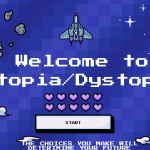Here is the link to my Twine. This was by far the most daunting task I have worked on. I have never worked with anything remotely like this and it really took me out of my comfort zone. This type of text work is completely different than the type I am used to. The creature comforts such as, drag and drop, the placement of images and the lack of spell check really showed me how I have come to rely on that functionality.
Everything was not in linear form like I am accustomed to. Bolter (2001, pg. 122) explains that a printed novel presents it’s episodes in one order, but the electronic writing space removes that restriction; the author may lay out a two- or even three-dimensional textual space within which her fiction operates. In Twine you create boxes of text and other attributes. There is formatting, which allows for the inclusion of graphics, and sounds. It took a while for me to figure out the inclusion of images in my story, but I never did figure out sounds.
Of course, I do not see hypertext transferring to the world of speech, as many of the other references Gretchen McCulloch discusses in the podcasts this week such as memes or the manipulation of language from the way we type and text on devices to the way we speak. The hypertext used for Twine is cumbersome for a beginner to learn the type required to place images texts and sound together, but perhaps when you are immersed within that format you can see the convenience of its functionality.
I am satisfied with my first foray into this Hypertext world, but the result feels quite simplistic than what I am used to producing.
References
McRaney, David and McCulloch, Gretchen. (Host & Guest). (2012–present). Because Internet [Audio podcast]. You are Not so Smart. https://omny.fm/shows/you-are-not-so-smart/194-because-internet
Bolter, Jay David. (2001). Writing space: computers, hypertext, and the remediation of print. New York, NY: Routledge.

